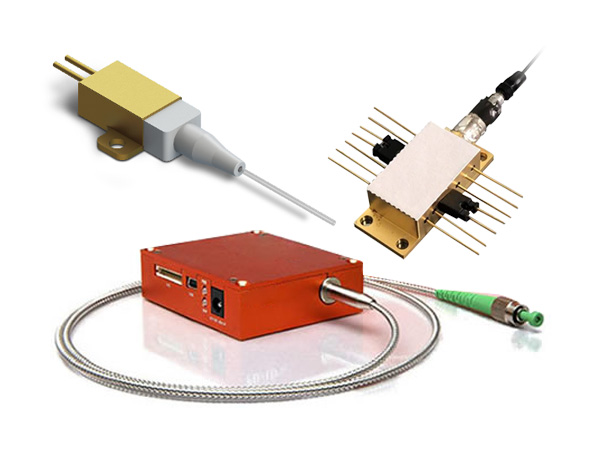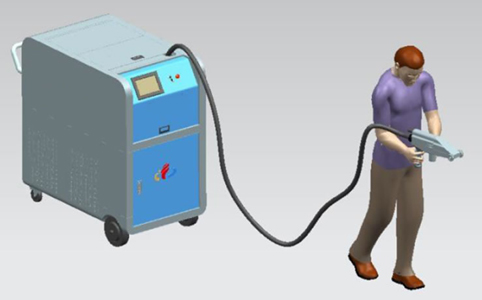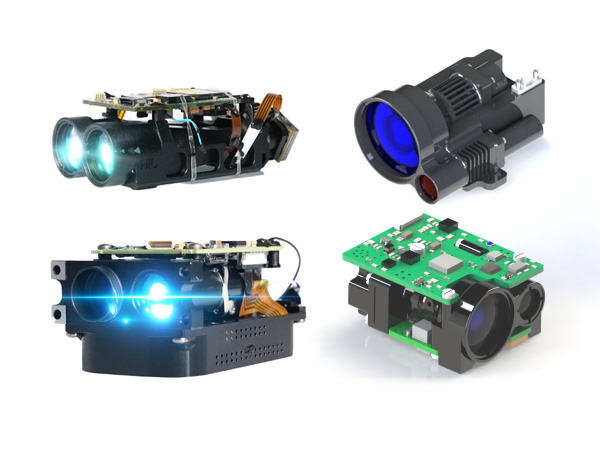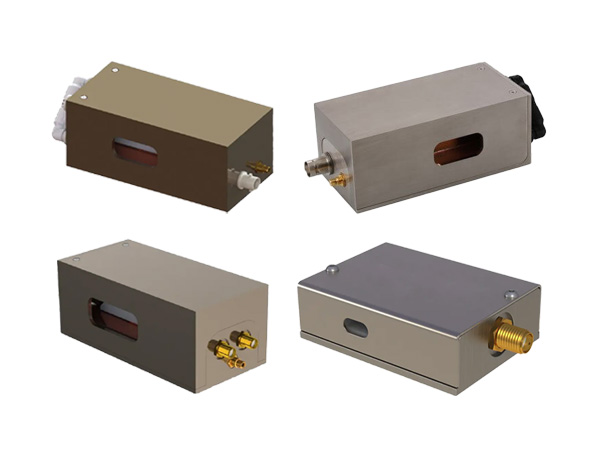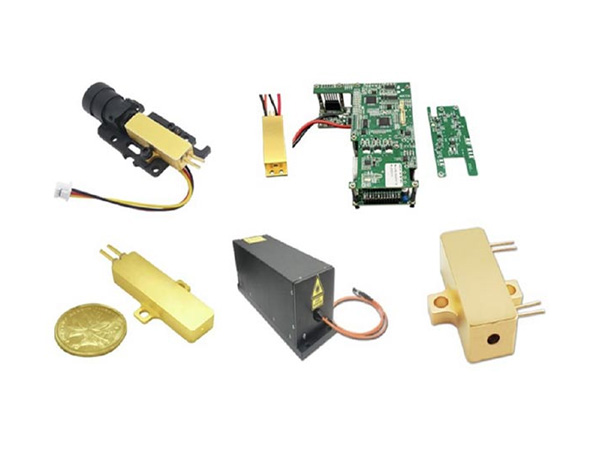Introduction to LBO Crystals
1. What is LBO crystal?
LBO crystal (lithium triborate, LiB3O5) is a nonlinear functional crystal material with excellent quality. It is currently a widely used frequency doubling device, with good optical uniformity inside the crystal, a wide transmission spectrum range, high nonlinear coupling characteristics, high matching efficiency and laser damage threshold, as well as good chemical and mechanical processing performance. It is widely used in key fields such as high-power frequency doubling, third harmonic, fourth harmonic, and sum and difference frequencies. Secondly, it also has good application prospects in parametric oscillation, parametric amplification, optical waveguides, and electro-optic effects. At present, the most widely used internationally is for doubling the frequency of medium and high power 1064nm laser to 532nm green light, or tripling the frequency of 1064nm laser to 355nm ultraviolet laser, as well as for OPO systems.
The uniqueness of LBO lies in its combination of a wide transparency range from ultraviolet to far-infrared, and extremely high damage thresholds. A high damage threshold is particularly important in many optical applications as it can handle high-power lasers without deteriorating or causing equipment failure. This incredible combination of functions has made LBO widely used in many optical systems, making it a true superstar in the field of nonlinear optics. In fact, if you delve deeper into the core of many modern laser systems, you may find that LBO crystals work tirelessly to convert and manipulate light with truly amazing efficiency and stability levels. In short, LBO is a game changing nonlinear optical crystal that is indispensable in today's optical field.

2. What fields are LBO crystals used in?
LBO crystals have consolidated their position as an indispensable part of the laser industry and made significant contributions to the advancement of laser technology. LBO crystals have a high damage threshold and excellent optical uniformity, which can withstand the common high-intensity output in high-power laser systems, effectively enabling these systems to achieve optimal performance without damaging their components. These crystals shine brightly in the field of frequency doubling, which is one of the most common nonlinear optical processes. Here, they convert one frequency of light into twice the frequency of light, thereby halving the wavelength. This process is crucial for manufacturing lasers of different colors and expanding their applications to various applications. This includes but is not limited to medical procedures, laser display systems, optical data storage, and even advanced research. LBO crystals are indispensable in these processes, not only stimulating the development of laser technology, but also fundamentally changing its applicability, making lasers a common feature in various aspects of our daily lives. The main applications include:
In terms of doubling frequency:
• Nd: YAG lasers for medical and industrial purposes; High power Nd:YAG and Nd:YLF lasers for scientific research and military purposes;
• pumping of Nd:YVO4, Nd:YAG, and Nd:YLF lasers; Ruby, Ti:Sappire, and Cr:LiSAF lasers.
In terms of triple frequency:
• Nd:YAG and Nd:YLF lasers;
• Optical parametric amplifier (OPA) and optical parametric oscillator (OPO); Second and third harmonic generation of high-power 1340nm Nd:YAP laser.
LBO crystals also have good application prospects in parametric oscillation, parametric amplification, optical waveguides, and electro-optic effects.
3. How are LBO crystals manufactured?
LBO crystals undergo decomposition reactions at around 834 ℃, generating 2Li2O • 5B2O3. Therefore, pure melt growth methods such as pull-up and descent methods cannot be used for crystal growth, and only the flux method can be used for crystal growth. There are many fluxes for growing LBO crystals, including LiF, Li2O, B2O3, MoO3, etc. Among them, MoO3 is a good flux, but using MoO3 alone can make the solution very unstable, and impurities, floating crystals, etc. are prone to occur during crystal growth. Therefore, other fluxes need to be added, that is, using a combination flux for growth. LBO crystals are grown using the flux method, and it is inevitable that extremely fine solutions will wrap inside the crystal. After growth, under the irradiation of green light laser, thicker scattering channels will be observed, and its body absorption value can reach tens to hundreds of ppm/cm. The manufacturing process of LBO crystals proves the height of scientific innovation. The Flux method is the cornerstone of LBO crystal manufacturing and is a meticulous process that involves precise mixing of raw materials, strict temperature control, and carefully managed chemical environment. It first mixes well calibrated lithium, boron, and oxygen in a crucible. Then expose the mixture to a precisely controlled thermal cycle to induce crystal growth. This carefully designed temperature distribution ensures that the mixture solidifies uniformly, forming a single crystal structure. A key aspect of the flux method is temperature gradient, which has a significant impact on the size and quality of crystals. Ensuring a stable temperature gradient is crucial for obtaining large, high-quality LBO crystals. Finally, when the crystal grows to the desired size, it is harvested, cut, polished, and coated according to its intended use. This strict and rigorous process achieves a perfect balance between size and quality in LBO crystals, reflecting the incredible optical properties of these crystals.
4. What are the optical properties of LBO crystals?
When it comes to the optical properties of LBO crystals, they do provide an impressive product portfolio. The wide transparency range from deep ultraviolet to far-infrared spectra enables LBO crystals to interact with a large number of laser sources, thereby enhancing their versatility in different applications. Most importantly, high damage threshold (LBO crystals can withstand high-intensity laser beams without affecting their structure or performance) is a highly appreciated quality, especially in high-power laser applications. In addition, LBO crystals have a large nonlinear coefficient. This characteristic is crucial in nonlinear optical processes such as frequency doubling, as it helps to effectively convert incident light into different frequencies. The wide acceptance angle further enriches their optical appeal. This feature can achieve more significant light interaction and minimize the requirement for beam alignment, thereby simplifying the overall operation. Last but not least, high optical uniformity ensures uniform propagation of light in the crystal, resulting in better beam quality and less distortion. The fusion of excellent optical properties enables LBO crystals to meet and surpass the needs of modern optics, laying the foundation for breakthrough discoveries and innovations in the field of optics. High quality LBO crystals should possess the following characteristics:
High optical quality: LBO crystals should have high optical transmittance, low scattering and absorption to ensure efficient laser transmission and conversion.
High nonlinearity coefficient: The nonlinearity coefficient of LBO crystals should be as high as possible to improve the conversion efficiency and output power of the laser.
High laser damage threshold: LBO crystals should have a high laser damage threshold to resist high-power laser irradiation and avoid crystal damage.
Good thermal stability: LBO crystals should have good thermal stability to ensure normal operation in high-temperature environments.
Good mechanical stability: LBO crystals should have good mechanical stability to resist mechanical impact and vibration, and avoid crystal fracture.
Good uniformity: LBO crystals should have good uniformity to ensure the stability of laser output power and beam quality.
In summary, high-quality LBO crystals should possess characteristics such as high optical quality, high nonlinearity coefficient, high laser damage threshold, good thermal stability, good mechanical stability, and uniformity to meet the needs of different laser applications.

5. How does LBO crystal compare to other nonlinear optical crystals?
When compared to other nonlinear optical crystals, LBO crystals undoubtedly hold their ground. Its broad transparency range is a unique feature that surpasses most other crystals in this field. This wide range enables them to interact with different laser sources, thus opening up a wide range of applications in various scientific and industrial fields. Another notable feature is their high damage threshold. Many optical systems, especially those involving high-power lasers, require crystals capable of withstanding high energy levels. Here, LBO crystals truly shine. They can withstand high-intensity laser output without causing continuous damage or degradation, which is a huge advantage that makes them the preferred choice for high-power applications. In addition, LBO crystals exhibit higher acceptance and smaller dispersion angles. These characteristics minimize the alignment sensitivity of the optical system and ensure better beam propagation. The less stringent alignment requirements and better beam quality brought about by these characteristics typically make LBO crystals more advantageous than other nonlinear optical crystals. In summary, the unique combination of performance and durability provided by LBO crystals makes it stand out in the field of nonlinear optics.
6. How to choose the right nonlinear optical crystal for your application?
Choosing the right nonlinear optical crystal (including LBO) is a crucial step for your successful application. However, this process involves careful evaluation of several key factors. Firstly, the size of the crystal plays a crucial role. Larger crystals can adapt to higher power levels, making them suitable for high-power applications. The receiving angle of a crystal is another key determining factor. Crystals with larger receiving angles (such as LBO) require lower alignment accuracy, making them easier to integrate into your system. The damage threshold of crystals is equally important, especially in high-power laser systems. LBO crystals have a high damage threshold, allowing them to withstand strong light without causing sustained damage, thereby improving the service life and reliability of optical devices. In addition, the properties of the laser system are a key factor. You need to consider the wavelength and power of the laser source, and choose a crystal that is transparent and capable of withstanding laser power at a given wavelength. Finally, other factors such as the thermal stability, optical uniformity, and nonlinear optical coefficient of the crystal need to be considered. All these factors collectively affect the performance and efficiency of optical systems, making the selection of the correct nonlinear optical crystal a decisive step towards successful implementation of applications.
7. What are the applications of LBO crystals in laser technology?
LBO crystals are renowned in the field of laser technology and have a wide range of applications, shaping the future of lasers and light. LBO crystals are commonly referred to as the heart of high-power lasers and play an important role in the complex operation of these laser systems. Due to their high damage threshold, they enable these high-power systems to achieve peak performance while ensuring durability. One of the most common applications is frequency doubling, where LBO crystals effectively convert the frequency of high-power lasers, effectively halve the wavelength, and open up a range of possibilities for laser applications. In addition, LBO crystals have made significant contributions to the field of optical parametric oscillation, which is an important process for generating tunable light sources. Here, they serve as platforms for generating two new beams of incident light, each carrying a different frequency. In addition, sum frequency mixing (the process of combining two different frequencies to generate a new frequency) also heavily relies on LBO crystals. This process is crucial for generating lasers of various colors, broadening the horizons of laser displays, medical applications, and more. Overall, the integration of LBO crystals and laser technology has broken through the boundaries that can be achieved with light, illuminating the path towards a brighter and brighter future.
8. What is the thermal stability of LBO crystals?
LBO crystals are known for their excellent thermal stability, which sets them apart and makes them indispensable in many optical systems. Especially when dealing with high-power lasers, thermal stability is crucial. Laser systems generate a large amount of heat, and without appropriate thermal resistance, crystals may degrade or even fail. But LBO Crystals has a firm stance. They can withstand a large amount of heat without causing any significant performance loss, ensuring that your optical system remains reliable and efficient even in harsh conditions. In addition to high-power lasers, this thermal stability also extends the applicability of LBO crystals to various environments with different temperature conditions. Whether it's low-temperature scientific experiments or high-temperature industrial processes, you can rely on LBO crystals to provide consistent performance. Their ability to maintain nonlinear optical properties over a wide temperature range further enhances their versatility. The realization of this thermal resistance effect is attributed to its unique crystal structure, which can remain stable and unchanged even under enormous thermal stress. Essentially, the thermal stability of LBO crystals proves their elasticity and reliability, making them the favorite of scientists and engineers worldwide.
9. Under what conditions is LBO crystal most stable?
LBO crystals can maintain stability under various conditions, demonstrating their versatility and elasticity. However, their optimal performance is usually achieved under certain temperature and pressure parameters. However, these conditions are not fixed and largely depend on the expected application of the crystal and the complexity of laser system design. Generally speaking, from a temperature perspective, LBO crystals exhibit high thermal stability and continue to function effectively over a wide temperature range. This broad range allows for flexible system design and ensures that crystal performance is not affected even under fluctuating temperature conditions. Under pressure conditions, LBO crystals are typically used in most optical applications under ambient pressure conditions. They maintain their structural integrity and optical properties under these conditions, ensuring reliable performance. However, if the application requires it, these crystals can also withstand certain high pressure conditions. It is always recommended to consult crystal experts or refer to specific manufacturer guidelines to determine the optimal conditions for your specific LBO crystal and application. In summary, the stability and performance of LBO crystals are influenced by various factors. However, their inherent flexibility and adaptability to various conditions make them unique, making them a reliable choice for many applications.
10. What is the cost of LBO crystals and what should be noted when purchasing?
When purchasing LBO crystals, the following are some things to pay attention to:
1. Crystal quality: The quality of LBO crystals is a key factor affecting their performance. When purchasing, it is advisable to choose crystals with good quality and stable optical performance to ensure that they can achieve the expected results during use.
2. Crystal size: The size of LBO crystals can affect their applicability and effectiveness. When purchasing, one should choose the appropriate size according to their own needs.
3. Crystal brand: LBO crystals from different brands may have differences in quality and performance. When purchasing, it is important to choose products from well-known brands to ensure their quality and performance.
4. Price: The price of LBO crystals is influenced by various factors, such as crystal quality, size, brand, etc. When making a purchase, you should choose the appropriate product based on your budget.
5. After sales service: When purchasing LBO crystals, it is advisable to choose suppliers or manufacturers who provide good after-sales service to ensure timely technical support and maintenance services during use.
In short, when purchasing LBO crystals, factors such as crystal quality, size, brand, price, and after-sales service should be comprehensively considered to choose a suitable product. Meanwhile, it is recommended to have sufficient communication with suppliers or manufacturers before purchasing, to understand the detailed information and usage precautions of the product. Although it is a high-quality product, its outstanding performance often proves that the investment is worthwhile.
Conclusion:
Exploring the world of LBO crystals is both interesting and insightful. Their unique performance and widespread application demonstrate their growing importance in optics and other fields. As we continue to harness the power of these extraordinary crystals, people can only foresee the extraordinary progress they promise to bring to our future. If you need to perform second or third harmonic generation on high-power diode pumped solid-state lasers, you should try using our non-destructive ultra smooth LBO crystals! The LBO crystals we provide have excellent surface quality with 2/1 scratches, customizable 0/0, and extremely low absorption coefficient: reaching 1-2ppm/cm at 1064nm. In addition, we can provide large-sized LBO components with dimensions up to 50 × 50mm2 and a maximum length of 40mm.
For more information on LBO product, please click here.
 English
English Français
Français Deutsch
Deutsch euskara
euskara Русский язык
Русский язык Italiano
Italiano Português
Português Nederlands
Nederlands Polski
Polski Greek
Greek Lietuva
Lietuva Türkçe
Türkçe 日本語
日本語 한어
한어 中文
中文 தாமில்
தாமில் فارسی
فارسی हिंदी
हिंदी Tiếng Việt
Tiếng Việt ภาษาไทย
ภาษาไทย Pilipino
Pilipino Indonesia
Indonesia தாமில்
தாமில்
